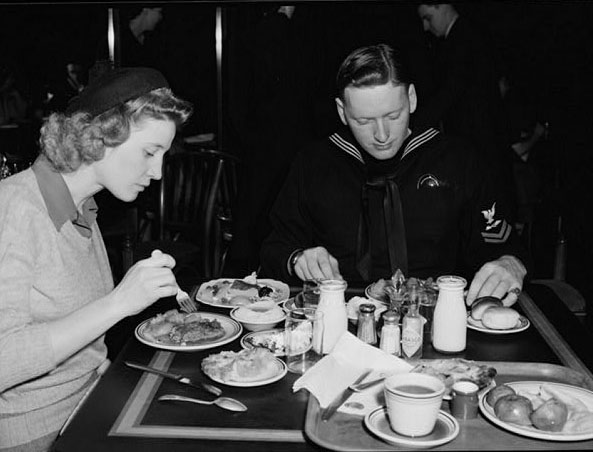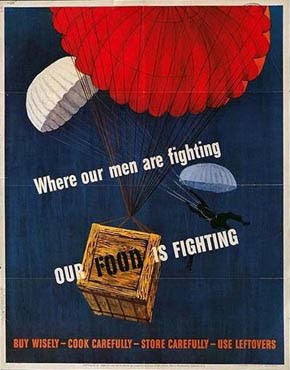
RED POINTS (Meats, Cheeses, Fats and Oils) -
TOTAL AVAILABLE: 64 pts
Turkey 5 lbs (bone in) - 15 pts
Macaroni and Cheese (2 boxes) - 1 pt
Butter (1 lb) - 16 pts
Canola Oil (32 oz) - 10 pts
Cheddar Cheese (1 lb) - 8 pts
Cream Cheese (8 oz) - 3 pts
Bologna (10 oz) - 3 pts
Bacon (1 lb) - 8 pts
TOTAL USED: 64 pts.
Whew! Barely scraped by, but if we weren't also rationing poultry we would have had much more wiggle room. That bacon was a last minute addition for Wednesday's dinner once I saw that we could afford the points. It's bacon!
BLUE/GREEN POINTS (Canned/Frozen/Dried Produce) -
TOTAL AVAILABLE: 192 pts.
Green Beans (2 cans) - 12 pts
Cream of Mushroom Soup (1 can) - 4 pts
Frozen Snap Peas (1 lb) - 12 pts
Fruit (2 cans) - 32 pts
Spaghetti Sauce (1 can) - 8 pts
Carrots (1 can) - 6 pts
Dried Black Beans (1 lb) - 2 pts
Chicken Broth (5 cans) - 20 pts
Raisins (3/4 lb) - 3 pts
Applesauce (25 oz) - 21 pts
Juice (48 oz) - 9 pts
Spinach (1 can) - 8 pts
TOTAL USED: 137 pts
Hmm...we still have 55 blue/green points to play with...which may come in handy (I'll 'splain later). We're really feeling the lack of fresh produce, especially fruit, since we are subject to seasonal availability just like our WWII civilian counterparts. I did splurge and by some clementines, though.
We also purchased our allotted two pounds of sugar and one adult's five-week coffee rations.

Here's our plans for all these rationed items, plus their non-rationed compadres:
Saturday: Roast turkey with gravy, green bean casserole, and stuffing (using day-old bread that had been stored in the freezer)
Sunday: Turkey and homemade noodle soup with cabbage salad
Monday: Sweet potato and (frozen) butternut squash soup with fresh-baked bread
Tuesday: Baked potatoes with cheese and sour cream and (frozen) snap peas
Wednesday: Pancakes, bacon and canned fruit
Thursday: Spaghetti marinara with carrots
Friday: Black bean soup with corn bread
Lunches this week consist mostly of left-overs, peanut butter and honey sandwiches and non-rationed dried soup mixes. Speaking of soup, the soup on Monday night was not that great. Really. Not good. Orange mush with too much pepper. But we ate it and I rewarded the family by baking our first historically-accurate treat: Lafayette Gingerbread (historical recipes will get their own blog post shortly). And I will fully disclose that we also finished off the last of the ice cream that was hibernating in the freezer since Eowyn's birthday party a few weeks ago. But that is gone now...long gone. Adios. Sigh.
Anyhoo, back to those extra blue/green points...we're getting together with a few friends on New Year's Eve and we need to bring some party noshings, so I imagine we'll be dipping into that surplus, plus providing some baked goods. No traditional little smokies or sweet and sour meatballs or cheese ball. But I also promise to not bring cans of cooked spinach and navy beans, either. I'll let you know what I come up with for that occasion.
Tomorrow night is our first experience with Mr. Bowles' Amazing Marketplace Scenario Randomizer. As challenging as it was to make a menu this week just keeping to basic points my mind already cramps a bit when I think about meal planning with key ingredients either missing or worth more points. Of course, they could also be worth less points...gotta keep the optimism going. Needless to say we'll keep you posted on what restrictions we'll be working with next week!
Be safe - there's a war on, you know!
--Rational Mama














